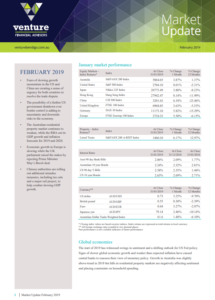The Pulse

- Fears of slowing growth momentum in the US and China are creating a sense of urgency for both countries to resolve the trade dispute
- The possibility of a further US government shutdown over border control is adding to uncertainty and downside risks to the economy
- The Australian residential property market continues to weaken, while the RBA cut its GDP growth and inflation forecasts for 2019 and 2020
- Economic growth in Europe is slowing while the UK parliament raised the stakes by rejecting Prime Minister May’s Brexit deal
- Chinese authorities are rolling out additional stimulus measures, including tax cuts and a major rail project, to help combat slowing GDP growth
Global economies
The start of 2019 has witnessed swings in sentiment and a shifting outlook for US Fed policy. Signs of slower global economic growth and weaker than expected inflation have caused central banks to reassess their view of monetary policy. Growth in Australia was slightly above-trend in 2018 but falls in residential property markets are negatively affecting sentiment and placing constraints on household spending.
Australia
Confidence in the Australian economy has taken a hit from the correction in house prices and a slowdown in global growth, both of which have led the Reserve Bank to reassess downside risks.
US
The US Fed began the new year struggling to regain its balance after being wrongfooted by markets as it attempted to address concerns surrounding its current tightening path.
Europe
Growth appeared to slow across Europe in December as political uncertainty and a confluence of one-off factors took their toll.
China
China is attempting to wean itself off its reliance on credit-fuelled investment spending, and with good reason given debt levels approaching 300% of GDP. However, given the additional threat of a trade war with the US and an increasingly cautious household sector, China appears to have reached the point where additional stimulus measures are required.
Asia Region
Japan’s September quarter GDP growth was revised down to a contraction of 2.5% annualised from an initially reported fall of 1.2%. The main factor was a downward revision to business investment, which fell 10.6% during the quarter (a significantly greater fall than the initial estimated drop of 0.9%).